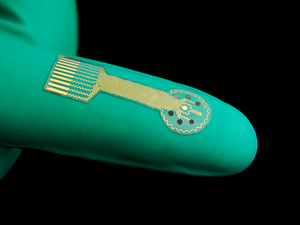Caltech researchers have developed smart bandages that contain embedded electronics and medication in a flexible and stretchy polymer. These bandages can monitor signs of inflammation and collect valuable medical data, providing targeted treatment to chronic wounds, particularly those of diabetic patients. The electronics in the bandage can monitor for molecules such as uric acid or lactate, as well as the pH level and temperature in the wound. The smart bandages can deliver medication directly to the wound site or apply a low-level electrical field to stimulate tissue growth, promoting faster healing. Animal models under laboratory conditions have shown that these smart bandages can provide real-time updates about wound conditions and metabolic states to researchers. Down the road, researchers hope to increase device stability and test the smart bandages on larger chronic wounds. The study was published in the journal Science Advances and funded by multiple organizations, including the National Institutes of Health and the National Science Foundation.
‘Smart’ Bandages: A Revolutionary Way to Monitor and Treat Chronic Wounds
Caltech researchers have developed a revolutionary new type of bandage designed for chronic wounds, particularly those of diabetic patients. These smart bandages can monitor signs of inflammation and collect valuable medical data that can be used to provide targeted treatment.
Chronic wounds are a significant problem, particularly for those with diabetes. The body’s natural healing process is disrupted in diabetic patients, and wounds can become infected and worsen. Chronic wounds are also a burden on healthcare systems, costing up to $25 billion in the United States alone each year.
The new smart bandage, developed in the lab of Wei Gao, an assistant professor of medical engineering, Heritage Medical Research Institute Investigator, and Ronald and JoAnne Willens Scholar, offers a possible solution to these problems. Unlike traditional bandages, which are often little more than layers of absorbent material, these bandages contain embedded electronics and medication in a flexible and stretchy polymer.
The electronics in the bandage can monitor for molecules such as uric acid or lactate, as well as the pH level and temperature in the wound. This data can be wirelessly transmitted to a nearby computer, tablet, or smartphone for review by the patient or a medical professional. Additionally, the bandage can deliver medication directly to the wound site to treat inflammation and infection or apply a low-level electrical field to stimulate tissue growth and faster healing.
Animal models under laboratory conditions have shown that these smart bandages can provide real-time updates about wound conditions and the animals’ metabolic states to researchers, as well as speed up the healing of chronic infected wounds similar to those found in humans. The results are promising, and future research will focus on improving the bandage technology and testing it on human patients, whose therapeutic needs may be different from those of lab animals.
In conclusion, the smart bandages developed by Caltech offer a promising solution to the problem of chronic wounds, particularly in diabetic patients. By monitoring for inflammation and infection and providing targeted treatment, these bandages may be able to improve the healing process, reduce healthcare costs, and improve patient outcomes.
Smart Bandages Show Promising Results in Chronic Wound Treatment
Caltech researchers have developed a stretchable wireless wearable bioelectronic system that can monitor and treat infected chronic wounds. The system can deliver antibiotics and electrical stimulation to stimulate tissue growth, promoting faster healing. The team aims to increase device stability and test it on larger chronic wounds as they acknowledge that wound parameters and the microenvironment may vary from site to site. The research was published in the journal Science Advances and funded by multiple organizations, including the National Institutes of Health and the National Science Foundation.
Disclaimer: The accuracy of news releases posted to EurekAlert! by contributing institutions or for the use of any information through the EurekAlert system is not the responsibility of AAAS and EurekAlert!.
Don’t miss interesting posts on Famousbio










